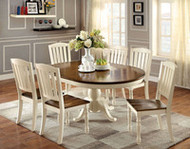3 Tips on Choosing the Right Kitchen Table
Posted by BM on 8th Sep 2015
Many people have homes that feature eat-in kitchens. On one end of the spectrum, owning a home with an eat-in kitchen allows the dining room to remain available for more formal gatherings or holidays. On the other end of the spectrum, one may own a home that does not feature a dining room at all, meaning the kitchen is the only place where traditional ‘sit-down’ meals are had. Taking the above scenarios (and countless others) into consideration, here are some tips on choosing the right kitchen table based on the following factors: shape, material, and height.
1- Shape
Kitchen tables come in a variety of shapes, so it is important to remember that the physical dimensions of the kitchen, along with structural considerations, such as load-bearing walls, may dictate someone’s final decision. This should not be seen as a deterrent, however, because tables come in a variety of shapes & sizes, as seen below:
Round or Oval: By far the most common of all kitchen table choices, round or oval tables are popular due to their space-saving nature, many of which are approximately between 36” and 60” in diameter. As evidenced by their use of pedestal bases, these tables typically take up less (actual) floor space when compared to their square or rectangular counterparts. As a result, round or oval tables can be used to help create a more intimate gathering, especially if the homeowner won’t be entertaining more than four to six people at a time. However, many tables feature drop-in or butterfly extensions should extra space be needed.
Square or Rectangle: These table designs typically look more natural and proportionate in longer, wider rooms. While not the most ideal choice for space-limited kitchens, sizing options means they can nevertheless make strong styling statements in kitchens that can easily accommodate them. Small square tables can comfortably seat four, while a typical rectangular table can typically seat up to six before extensions should be considered.
2- Material
Wood: Synonymous with furniture, this versatile material will continue to be the basis of quality furniture as long as there are trees on Earth. Many types of wood can used in the construction of the table, but oak and pine are the two most commonly used for cost & availability reasons. Finishes vary by set.
Metal/Chrome: For those seeking to put a nostalgic spin on their kitchen decorum, look no further than a metal/chrome table. A chrome-plated finish adds style and durability. Just don’t be surprised if you find yourself craving root beer floats more often!
Glass Top (Over Metal or Wood): Glass is always a popular decorating option anywhere in the home because it goes with almost everything! The kitchen is no exception… A glass-topped kitchen table with a metal or wood base makes for a clean and casual setting with which to share meals with loved ones.
3- Height
Standard height: Standard height for kitchen and dining tables is 30”. Most tables are built with this one dimension as an industry-wide standard.
Counter height: As an alternative to standard height tables, counter height tables typically stand 36” to 39” tall. As a result, they will require a taller chair or stool to comfortably seat everyone.
Making a decision regarding what kind of kitchen table to purchase is ultimately a matter of personal choice, once room or space limitations have been considered. Having a variety of choices allows us to express our style, tastes, and beliefs to those we meet through the decisions we make. By using these tips, we hope the right kitchen table for your home is just a mouse-click away!





